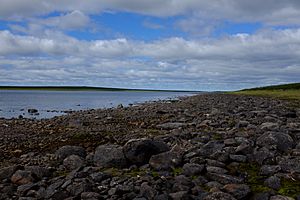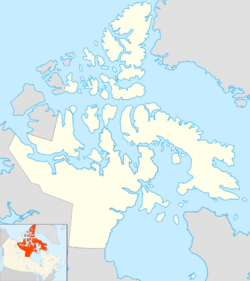Angikuni Lake facts for kids
Quick facts for kids Angikuni Lake |
|
|---|---|

Angikuni Lake, July 2014
|
|
| Location | Kivalliq Region, Nunavut |
| Coordinates | 62°12′N 99°59′W / 62.200°N 99.983°W |
| Primary inflows | Kazan River |
| Primary outflows | Kazan River |
| Basin countries | Canada |
| Surface area | 510 km2 (197 sq mi) |
| Surface elevation | 257 m (843 ft) |
| Islands | Many |
| Settlements | uninhabited |
Angikuni Lake (also called Lake Anjikuni) is a large lake in Nunavut, Canada. It is found in the Kivalliq Region. This lake is one of many lakes along the Kazan River. Ennadai Lake is to the south, and Yathkyed Lake is to the north.
Contents
Exploring Angikuni Lake's Geography
The lake's edge has many rocky areas. These rocks are part of the Canadian Shield, which is a very old and stable part of Earth's crust. It is specifically part of the Hearne Domain.
Wildlife Around Angikuni Lake
Many Barren-ground caribou travel through this area. The lake is also home to several types of fish. You can find Lake trout, Northern pike, and Arctic grayling in its waters.
History and Explorers
In 1948, a Canadian explorer named Farley Mowat visited Angikuni Lake. At that time, it was part of the Northwest Territories. Mowat found a cairn (a pile of stones) that was built in a way he hadn't seen before from the local Inuit people.
The Mysterious Cairn
Inside the cairn, Mowat found pieces of a wooden box. The box was made with special dovetailed corners. Mowat knew that only one other European explorer, Samuel Hearne, had been in this region before him, back in 1770. Mowat thought that the cairn might have been built by Francis Crozier. Crozier was part of Franklin's lost expedition, which disappeared in 1848 while searching for the Northwest Passage.
The Legend of the Vanishing Village
Angikuni Lake is well-known for a strange story. In 1930, a news reporter in The Pas, Manitoba, wrote about a small Inuit village near the lake. This village was known for welcoming fur trappers.
Joe Labelle's Discovery
In 1930, a fur trapper named Joe Labelle visited the village. He knew the villagers well. But when he arrived, he found the village completely empty. It looked like everyone had left very suddenly. He saw unfinished shirts with needles still in them. Food was still hanging over fire pits, as if people had just walked away.
Strange Findings
Even stranger, Labelle found seven sled dogs that had died from starvation. He also found a grave that had been dug up. Labelle knew that an animal couldn't have done this. The stones around the grave were still in place. He reported his findings to the Royal Canadian Mounted Police (RCMP).
The Search and the Mystery
The RCMP started a search for the missing people. However, no one from the village was ever found. This mysterious event became a popular story. It appeared in books like Frank Edwards's 1959 book Stranger than Science. Other versions of the story added details like mysterious lights in the sky. Some even claimed over a thousand people went missing.
The RCMP's Explanation
After the story appeared in newspapers, the RCMP looked into it. In 1931, Sergeant J. Nelson filed a report. He said he could find "no foundation for this story." Nelson questioned if Joe Labelle had been in the area before, as the newspaper article claimed. He also noted that the reporter, Emmett E. Kelleher, was known for "colorful stories."
The RCMP now says the case is an urban legend. They believe the story started with Frank Edwards's book. The RCMP also stated that such a large village would likely not have been possible in such a remote area. They have no official records of any unusual events in the area.
Debunking the Claims
Brian Dunning, a writer who investigates strange claims, also looked into the story. He found that the November 1930 newspaper article by Emmett E. Kelleher did exist. While the story was published, Dunning still considers it "dubious."



